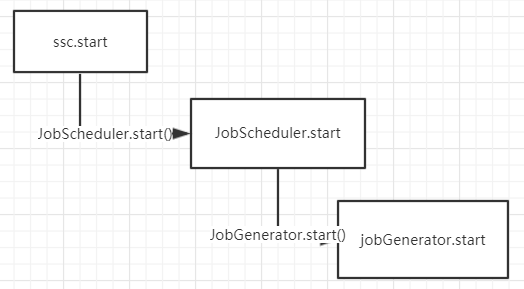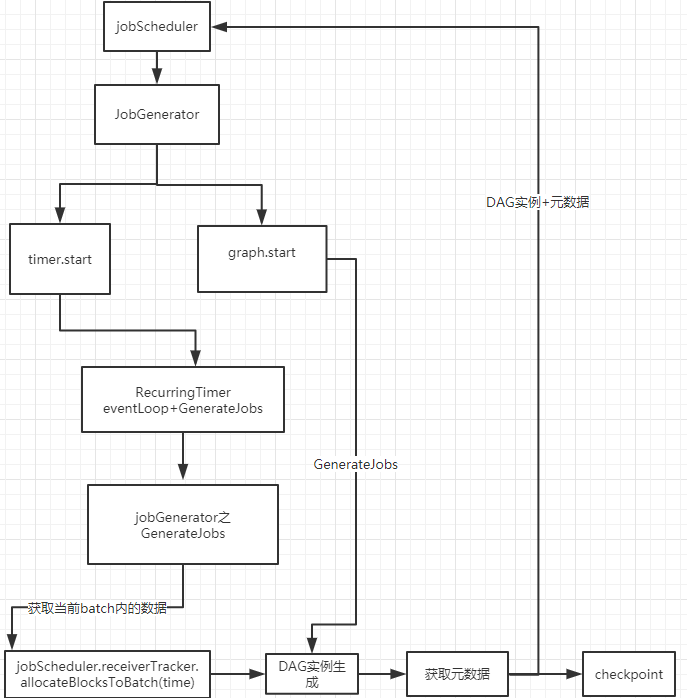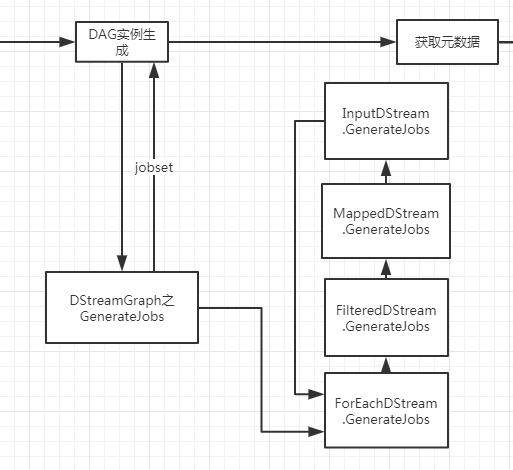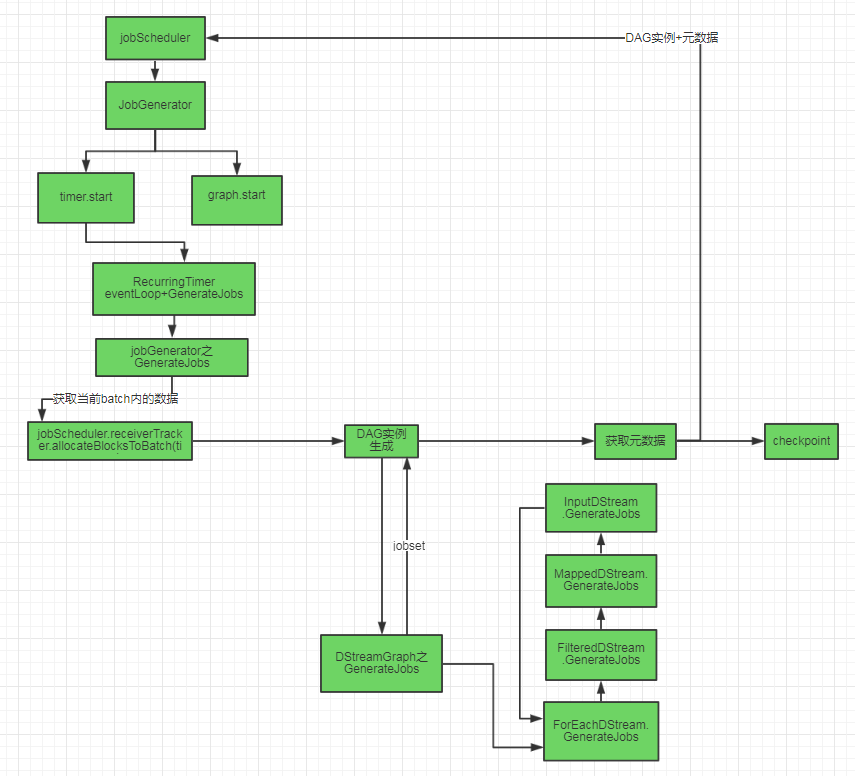前面一篇讲到了,DAG静态模板的生成。那么spark streaming会在每一个batch时间一到,就会根据DAG所形成的逻辑以及物理依赖链(dependencies)动态生成RDD以及由这些RDD组成的job,并形成一个job集合提交到集群当中执行。那么下面我们具体分析这三个步骤。
首先从JobScheduler讲起。在本节所需要了解的是JobScheduler的两个重要对象。jobExecutor与JobHandler。jobExecutor是一个名为streaming-job-executor的线程池,JobHandler是一个继承自Runnable的线程类。提交过来的JOB将提交到到这里执行。
private val jobExecutor = ThreadUtils.newDaemonFixedThreadPool(numConcurrentJobs, "streaming-job-executor")


private class JobHandler(job: Job) extends Runnable with Logging { import JobScheduler._ def run() { val oldProps = ssc.sparkContext.getLocalProperties try { ssc.sparkContext.setLocalProperties(SerializationUtils.clone(ssc.savedProperties.get())) val formattedTime = UIUtils.formatBatchTime( job.time.milliseconds, ssc.graph.batchDuration.milliseconds, showYYYYMMSS = false) val batchUrl = s"/streaming/batch/?id=${job.time.milliseconds}" val batchLinkText = s"[output operation ${job.outputOpId}, batch time ${formattedTime}]" ssc.sc.setJobDescription( s"""Streaming job from <a href="http://t.zoukankan.com/$batchUrl">$batchLinkText</a>""") ssc.sc.setLocalProperty(BATCH_TIME_PROPERTY_KEY, job.time.milliseconds.toString) ssc.sc.setLocalProperty(OUTPUT_OP_ID_PROPERTY_KEY, job.outputOpId.toString) // Checkpoint all RDDs marked for checkpointing to ensure their lineages are // truncated periodically. Otherwise, we may run into stack overflows (SPARK-6847). ssc.sparkContext.setLocalProperty(RDD.CHECKPOINT_ALL_MARKED_ANCESTORS, "true") // We need to assign `eventLoop` to a temp variable. Otherwise, because // `JobScheduler.stop(false)` may set `eventLoop` to null when this method is running, then // it's possible that when `post` is called, `eventLoop` happens to null. var _eventLoop = eventLoop if (_eventLoop != null) { _eventLoop.post(JobStarted(job, clock.getTimeMillis())) // Disable checks for existing output directories in jobs launched by the streaming // scheduler, since we may need to write output to an existing directory during checkpoint // recovery; see SPARK-4835 for more details. PairRDDFunctions.disableOutputSpecValidation.withValue(true) { job.run() } _eventLoop = eventLoop if (_eventLoop != null) { _eventLoop.post(JobCompleted(job, clock.getTimeMillis())) } } else { // JobScheduler has been stopped. } } finally { ssc.sparkContext.setLocalProperties(oldProps) } } } }
另外两个需要了解的对象,jobGenerator以及receiverTracker。jobGenerator负责job的动态生成,receiverTracker负责数据源的接收以及接收以后的transformation,以及根据这些转换形成DAG模板。随着JobScheduler启动的时候,jobGenerator以及receiverTracker也将启动。


def start(): Unit = synchronized { if (eventLoop != null) return // scheduler has already been started logDebug("Starting JobScheduler") eventLoop = new EventLoop[JobSchedulerEvent]("JobScheduler") { override protected def onReceive(event: JobSchedulerEvent): Unit = processEvent(event) override protected def onError(e: Throwable): Unit = reportError("Error in job scheduler", e) } eventLoop.start() // attach rate controllers of input streams to receive batch completion updates for { inputDStream <- ssc.graph.getInputStreams rateController <- inputDStream.rateController } ssc.addStreamingListener(rateController) listenerBus.start() receiverTracker = new ReceiverTracker(ssc) inputInfoTracker = new InputInfoTracker(ssc) val executorAllocClient: ExecutorAllocationClient = ssc.sparkContext.schedulerBackend match { case b: ExecutorAllocationClient => b.asInstanceOf[ExecutorAllocationClient] case _ => null } executorAllocationManager = ExecutorAllocationManager.createIfEnabled( executorAllocClient, receiverTracker, ssc.conf, ssc.graph.batchDuration.milliseconds, clock) executorAllocationManager.foreach(ssc.addStreamingListener) receiverTracker.start()// jobGenerator.start()// executorAllocationManager.foreach(_.start()) logInfo("Started JobScheduler") }

JobGenerator 启动
本节先按下 receiverTracker不表。先说jobGenerator。我们首先来看看它的start函数。首先启动一个待命的线程。然后根据上次的spark streaming任务是否执行了checkpoint来决定是执行restart()还是startFirstTime()。
/** Start generation of jobs */ def start(): Unit = synchronized { ...... eventLoop.start() if (ssc.isCheckpointPresent) { restart() } else { startFirstTime() } }
因为只为弄清流程原理,我们只看第一次启动的情况。
/** Starts the generator for the first time */ private def startFirstTime() { val startTime = new Time(timer.getStartTime()) graph.start(startTime - graph.batchDuration) timer.start(startTime.milliseconds) logInfo("Started JobGenerator at " + startTime) }
首先graph.start(startTime - graph.batchDuration)传递一个时间参数给DStreamGraph,告知其batch启动时间,并初始化相关参数。然后启动定时器。
RecurringTimer
代码如下
private val timer = new RecurringTimer(clock, ssc.graph.batchDuration.milliseconds, longTime => eventLoop.post(GenerateJobs(new Time(longTime))), "JobGenerator")
其实就是往eventLoop线程里加入GenerateJobs。即定时根据DAG模板生成当前batch的DAG实例。注意这里是jobGenerator的GenerateJobs。
jobGenerator之GenerateJobs
/** Generate jobs and perform checkpointing for the given `time`. */
private def generateJobs(time: Time) {
SparkEnv.set(ssc.env)
Try {
jobScheduler.receiverTracker.allocateBlocksToBatch(time)
graph.generateJobs(time)
} match {
case Success(jobs) =>
val streamIdToInputInfos = jobScheduler.inputInfoTracker.getInfo(time)
jobScheduler.submitJobSet(JobSet(time, jobs, streamIdToInputInfos))
case Failure(e) =>
jobScheduler.reportError("Error generating jobs for time " + time, e)
}
eventLoop.post(DoCheckpoint(time, clearCheckpointDataLater = false))
}它做了五件事情。
首先,通知jobScheduler获取当前batch需要处理的数据。
然后调用DStreamGraph的GenerateJobs函数真正去执行操作。
第三,将第一步获取到的数据保存在inputInfoTracker中。这部份被称之为元数据。什么叫元数据,就是最开始没有经过各种转换的数据。
第四,将生成的RDD实例以及元数据一同提交给jobScheduler。这部份是提交到jobExecutor这个线程池里异步执行的。
再然后后将一个checkpoint任务异步交给eventLoop去执行。
InputinfoTracker
可能有人会发现上面的表述中,第一和第三步有点雷同。但其实它们是不一样的。
我们追踪jobScheduler.receiverTracker.allocateBlocksToBatch(time)最终得到的数据结构为:
private[streaming] case class ReceivedBlockInfo(
streamId: Int,
numRecords: Option[Long],
metadataOption: Option[Any],
blockStoreResult: ReceivedBlockStoreResult
)
jobScheduler.inputInfoTracker.getInfo(time)最终得到的数据结构为:
case class StreamInputInfo( inputStreamId: Int, numRecords: Long, metadata: Map[String, Any] = Map.empty) { require(numRecords >= 0, "numRecords must not be negative") def metadataDescription: Option[String] = metadata.get(StreamInputInfo.METADATA_KEY_DESCRIPTION).map(_.toString) }
对比发现,两种数据结构都有streamId(inputStreamId),numRecords,metadataOption,区别在于blockStoreResult。而且第三步获取到的元数据有句注释:Map to track all the InputInfo related to specific batch time and input stream。意为跟踪所有输入流信息和处理记录号的跟踪器。
// Map to track all the InputInfo related to specific batch time and input stream. private val batchTimeToInputInfos = new mutable.HashMap[Time, mutable.HashMap[Int, StreamInputInfo]]
InputInfoTracker的注释是This class manages all the input streams as well as their input data statistics. The information will be exposed through StreamingListener for monitoring.还有,StreamInputInfo注解为@DeveloperAPI。
我的理解是第一步所做的是获取到数据。第三步所做的是给这些数据加上属性,提供给开发者查询展示监控。
到目前为止,我们分析了动态调度的流程,整个流程如图:

DAG实例生成
上面仅仅是分析了动态调度的问题,而DAG实例究竟是怎样生成的?

总结

到这里为止,我们根据DAG模板拿到了DAG实例,以及数据。那么接下来,会根据DAGScheduler划分task,stage。